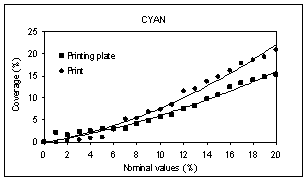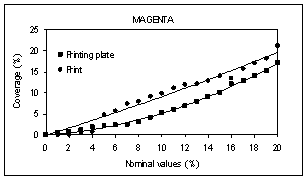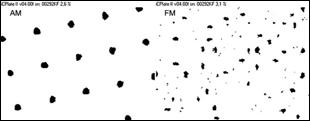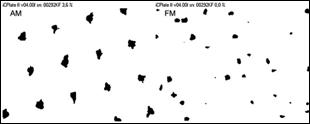WITHIN DIFFERENT SCREENING METHODS
Mahovic, S.; Mandic, L. & Gojo, M.
Abstract: Digitalization of the graphic production and the introduction of CtP processes in the printing form production have become priorities in printing companies business running. With the CtP systems for production the printing forms the usage of the frequency modulated screen (FM) is expanding apart from the conventional screens (AM). Application in the practice shows a series of adaptations of the system to particular jobs in order to achieve high quality reproductions. Reproduction of the originals on which highlight tones prevail is the object of this work investigation. The original is reproduced in the same CtP workflow and it is printed in offset. By measuring the mechanical characteristics of the printing elements and screen elements on the places of lighter tones, the differences in the print quality are define, and the visual evaluation was made. Such research will simplify the choice of particular screen in graphic reproduction, especially in reproducing the originals and photographs with prevailing lighter tones.
Key words: highlight tones, AM and FM screening methods.
1. INTRODUCTION
“Computer to Plate”(CtP) is the term used for describing computer controlled direct plate making process. As the majority apparently revolutionary discoveries CtP technology is in fact the product and the result of investigation in several different areas. The expansion of the usage of the printing forms, laser technology, photopolymer chemistry and DTP influenced the creation of the existing CtP system. The development of CtP process is visible in the speed and the quality increase of the reproductions with minimal production costs (Mahovic et. al., 2003). The quality of the print-out is increased by the application of the verified screening methods in the analogue processes as well as by the development of the new screening methods for digital processes of the printing form production.
2. BACKGROUND
Computer controlled direct print-out represents the system of control and processing the data in the screening device (screening image processor RIP), and the computer control of the imaging device (platesetter). For each type of reproduction the transformation of the data into the bit mapped data is performed. In dependence on the further reproduction process, the bitmapped data are adapted to the demands in quality and activity of the output unit on one hand and on the other hand they enable the defining the necessary specifications and the control signals for further reproduction. The quality of digital data is verified before their transfer to the output unit, which can be the imagesetter, the platesetter, and the device for proofs and reproduction realization. The two most often applied screening methods are: The amplitude-modulated (AM) screening which consists of dots of different sizes according to tone value, but at the constant distance from one another. And the frequency modulated screening (FM), which places identical size dots in a random pattern to simulate a continuous tone image (Mahovic et. al., 2004). Both screening methods are used in this work and the original is reproduced by direct computer plate making method. It is the question about the printing forms with the photoactive layer based on silver-halide and the platesetter with internal drum design (Adams & Romano, 1996). During imaging the printing form is placed within the drum and it is static during the process. On the geometrical axis within the drum there is the rotating mirror. The laser beam is reflected from the mirror and it comes to the middle axis of the drum and the rotating mirror which is reflected from, onto the surface of the printing form. Such architecture of the device is suitable for obtaining the high quality print-out on the printing forms; because the printing form is static and the problems of printing form vibration during the print-out process is thus eliminated.
3. EXPERIMENTAL
The investigations in this work are based on the fact that the reproductions of the photographs on which the lighter tones prevail belong to the group of the printed products with high demands. It means that the preparation of such product must be specially performed in order to obtain high quality reproduction and the printing department must be adapted to such demands. Because of that, the reproduction of the lighter tones is separated in this work and through the application of AM and FM screening methods it was found out which of them is more suitable for obtaining high quality prints less subjected to the aberrations in the quality.
For this investigation the photographs with prevailing highlight tones were defined and control wedges were computer generated with the patches from 1% surface coverage up to 20% surface coverage, with the increase of 1% (for CMYK). The imaging on the printing forms was done by the AM and FM screening methods and the printing was done in the offset technique. Measuring and binary images were performed by Gretag Macbeth IC Plate II Platereader.
4. RESULTS AND DISCUSSION
By AM and FM screening, the surface coverage on the printing forms and prints was uniform for process colours (CMYK) (examples for Cyan and Magenta are in figures 1, 2, 3, 4).
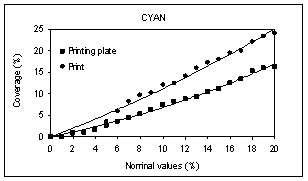
Fig. 1. Coverage on the printing plates and on the prints (AM).
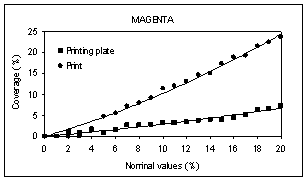
Fig. 2. Coverage on the printing plates and on the prints (AM).
